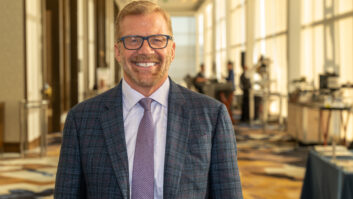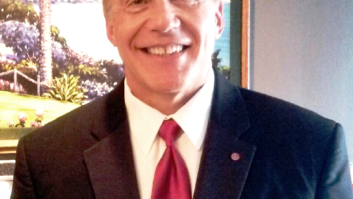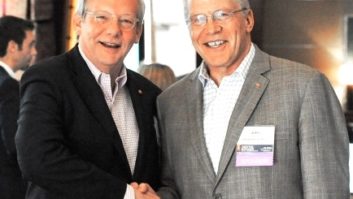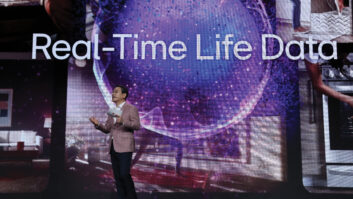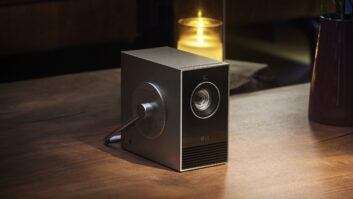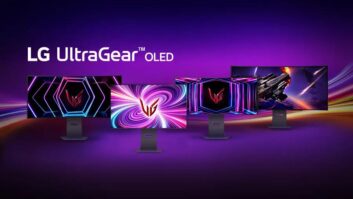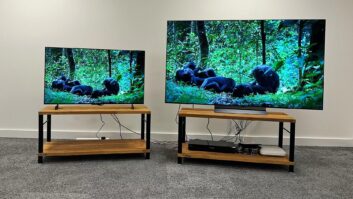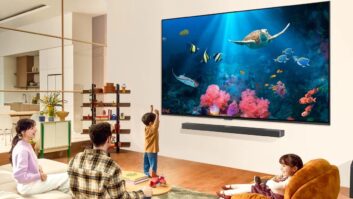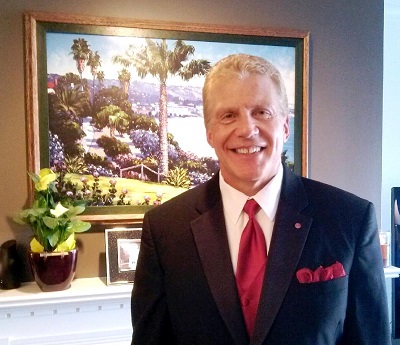
The following is an extended version of an interview appearing in the June 1 print edition of TWICE.
NEW YORK – John Riddle, the recently promoted home appliances senior sales VP at LG Electronics USA, truly is a son of the white-goods industry.
Brought up in the family business – Riddle’s Appliance, an independent Pennsylvania dealer – he went on to hold key sales management positions at Maytag, where he spent more than two decades.
He followed that with stints at Philips and Electrolux before joining LG in 2011.
TWICE recently caught up with Riddle on the road where he described LG’s role in the marketplace and the current state of the major appliance industry.
TWICE:So you really were born into the business.
Yes. My dad opened up a GE dealership with $500 after he got back from the war in 1945, and stayed in it all his life. I grew up on the delivery truck, doing odd jobs, and helping out the parts department and service. When I would finish that I would go change and come into the store with a tie and work the floor. I learned a lot during those years.
TWICE:What were some of your key takeaways from your time at Maytag?
At the time that I was vice president and general manager of the builder solutions group we had a very dynamic, charismatic CEO, Lloyd Ward. He had a Proctor & Gamble background and came to us from Frito-Lay where he was president, working for PepsiCo’s Roger Enrico.
My first 15 years within Maytag was learning all about the strength of Maytag, which at the time was an internally-focused and mostly a domestic U.S. company. But my last six and a half years were really about becoming aware that there were different ways to win besides the traditional ways we had followed at Maytag, which were much more conservative.
Lloyd brought new ideas and new thought processes, new ways to win. His vision was how to own the home, how to own the customer, and I learned a lot during that phase about how someone who had been in different industries could apply some leadership principles to any industry at the time.
TWICE:Flash-forward to your recent promotion to senior VP over all LG home appliances and channels. How does this change the organization?
It’s important for us because it will open up a lot of opportunities for local people within LG, opportunities that are more vertical, opportunities to move into different areas of the business. Our leadership is certainly driving us in that direction, to have a lot of involvement in the path for U.S. employees.
TWICE:The LG brand has had quite a trajectory since its U.S. launch over a decade ago.
Some of our first customers in the U.S. – regional customers and Home Depot – are now celebrating 10, 11 years with us. So we’re still a young company in the U.S. major appliance business.
TWICE:How would you define the LG brand? Where does it fit in the marketplace?
We’re in laundry and kitchen, and we’re mass premium, so most of our products would not be at [opening price point]. In laundry products for example, in many cases we don’t compete in areas with some of the largest unit shipments, say below $599 in a top-load washer. That’s a strategic decision.
And in refrigeration we are really focused in multi-door, French door product.
Cooking and dish much the same, but our market share is certainly more meager in those categories, which were introduced later.
TWICE:Manufacturing is still done in Korea?
Mexico for some products, and then Korea and China as well.
TWICE:How much of a disruption was the West Coast port dispute?
Quite a bit. Really since summer of last year we had disruption associated with Long Beach (Calif.). But we took a lot of pro-active steps as a company to make sure that we’re improving our on-time delivery of products. We started using other ports, like Houston, so that we are more diversified and are not reliant as much on Long Beach for access to our products coming in. We certainly see that other ports like Savannah (Ga.) and Newark (N.J.) are logical for us as well.
TWICE:Just when we think appliances engineers can’t take these products any further, you guys come back with something novel.
I don’t know that I’ve ever seen a time at LG where we’ve had as many exciting things on our product road map in major appliances as we do for the next 18 months. And it’s really across all categories of product.
What we’re calling the Sidekick washer – the pedestal washer – is really unique. It’s funny how some of the best ideas are simple in nature. We’re getting very strong feedback from our customers and from focus groups on that product, so we’re anxious to get it launched.
Certainly the new design within our front-load product, which has controls on the doors, is very ergonomic. You don’t have to stoop; the detergent trays are on top and covered; and they’re also enlarged so it’s easier to pour and avoid spills.
We also launched our EasyLoad dryer door which pulls down to use as a laundry chute for loading and then can swing out in the traditional fashion to make it easier for unloading.
And we launched our hybrid dryer, which has great eco-green savings, and can be used both on the normal setting and on the hybrid setting. We’ve been successful with a number of utilities giving us endorsements of that product, and it is a vented dryer so it offers the more commonplace installation capability of a vented product.
We’re also really excited about a new finish for our new Diamond Collection called black diamond, which is a three-layered application of a different stainless steel, and gives a black-diamond kind of finish. It is fingerprint-proof; it does not scratch; you could actually write on it with a permanent marker and clean it off; and it’s a beautiful finish that will give builders, certified kitchen designers and people remodeling their homes a differentiated look from stainless, which has been so popular but doesn’t have a lot of options in the industry today.
TWICE:What’s your read on the health of the industry?
I think it’s good. If you look at it on a macro level, most of the economic indicators are positive. Housing prices have been on the upswing so people are feeling better about their home value appreciating. That’s a good feeling if you’re going to invest in the No. 1 room of your home that has an ROI, your kitchen. So those kind of projects that count for a lot of sales – a refresh of your laundry room, a refresh of your kitchen – hold good prospects for us.
Also, if you look at most of the forecasting that’s being done around the AHAM 6 [a core category grouping], it’s around 4 to 5 percent. That includes builder, but still, a big part of that number, 2 to 3 percent, is going to be on the retail side.
TWICE:Aren’t we also anniversarying a major replacement cycle?
Yes, the replacement cycle for major appliances is typically seven to eight years, and with the exception of 2010 when President Obama had a rebate program for clunkers, there were many down years since ’06. All those years you had pent-up demand on this replacement cycle, so we think that bodes very well for the industry over the next three years.
TWICE:And yet it seems that the appliance industry is going down the same promotional road that broke the TV business.
I think we are seeing a more promotional industry. As you look at the major promotions now, in general some have gotten longer and there’s been deeper promotional cadence.
LG’s point of view is that we should certainly participate from a sales event standpoint, but because we are so focused on mass premium and premium, we’re trying to drive additional ASPs [average selling prices] with innovation. That includes all the products that I talked about and more –active convection in ranges, our new turbo-wash dishwasher – all those products are designed to add an upside to ASPs.
So we do see some of those [deflationary] trends, and I’m concerned to see this for our industry. However, we still are very bullish on the opportunity for growth, and for profitable growth, in this business.
TWICE:Talk to me about channel management. How do you keep everyone, the big guys and the not so big guys, feeling loved?
We’re really trying to drive a very customer-focused, customer-centric organization. That includes improving our ability to deliver on time; improving our supply of product to our local partners; and being consistent in how we do our promotional cadence, so each month customers don’t have to feel unsure about which direction we’re heading in as a company.
I think we’ve been very good as an organization and as a leader in the industry with things like our MAP policy, which we created in 2011, both online and in print, to be able to have integrity in the marketplace. We’re also being a leader in driving new products to the market like front-control top-load laundry, which helped create new categories of business, and in trying to balance that among the different channels of the trade. We probably started out strong in one or two channels, and gradually broadened to where we’ve formed good relationships across different parts of different channels.
TWICE:How is LG reacting to all the marketplace changes on the vendor side, like Electrolux’s acquisition of GE and aggressive share plays by some manufacturers?
As a company you keep an eye on all those things and you try to stay focused on what we’re doing in the marketplace. We continue to build our brand, and we’re a company that differentiates from a lot of our competitors because we go more broadly than major appliances and have other divisions that also touch many of our customers. That gives us an opportunity to leverage in the marketplace.
It’s also about being a customer-focused organization that’s driving innovation – new products creating new categories of business, pushing ASPs for the retailer, and bringing this exciting innovation stream of products to U.S. consumers that will make them, in many cases, want to replace their old appliance before it just fails.
TWICE:You mentioned leveraging LG’s mobile and CE prowess. How do you ‘Flex’ those muscles?
When we do more senior-level customer meetings or if we’re doing a quarterly review, we oftentimes share those meetings with the HE [home entertainment] division. And certainly within the buying groups Rick Calacci [senior VP home entertainment sales] is always with us. If you look at our booths you can see that they’re more than just an LG Appliance booth, they’ve got all of LG Electronics in them as well. So whether it is CES or a buying group show or a major customer event, we’re certainly trying to do more to have more products represented because it is such a strong differential for LG.
TWICE:Does the same hold true in your consumer marketing?
It depends on the retailer and it depends on the campaign. But if you look at things we’ve done like our partnership with NCAA and the March Madness events, I think those are the right kind of opportunities for us to promote the whole line together, and provide an umbrella promotion with co-equity efforts underneath for retailers like Best Buy or P.C. Richard who sell both categories.
TWICE:Is it still too soon for connected home appliances?
I can remember talking about smart appliances when I was still at Maytag in the builder division, so the concept has been around a long time. It required different means because things were not wireless, you didn’t have robust platforms the way we do today with the capability of hand-held devices.
So I think ‘smart’ as in a connected appliance has tremendous potential. But for now, in most cases their introduction is in flagship products, and we have to continue as an industry to see where the legs are for this and how we can best introduce it to the consumer. Maybe in an area with new, energy-efficient homes, we should start by working with builders or large builder distributors. There may also be some opportunities for us with products like the hybrid dryer to work with like-minded utilities that want to drive something that’s going to save energy.
I think we need help in that area as an industry to get it within arm’s reach of the consumer in a good way. I love the idea and the concept; it’s just that right now it’s not at the point of achieving scale.




